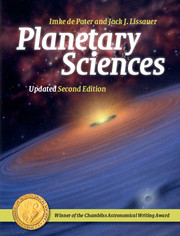Book contents
- Frontmatter
- Contents
- List of Tables
- Preface
- 1 Introduction
- 2 Dynamics
- 3 Solar Heating and Energy Transport
- 4 Planetary Atmospheres
- 5 Planetary Surfaces
- 6 Planetary Interiors
- 7 Magnetic Fields and Plasmas
- 8 Meteorites
- 9 Minor Planets
- 10 Comets
- 11 Planetary Rings
- 12 Extrasolar Planets
- 13 Planet Formation
- Appendix A List of Symbols Used
- Appendix B Acronyms Used
- Appendix C Units and Constants
- Appendix D Periodic Table of Elements
- Appendix E Observing Techniques
- Appendix F Interplanetary Spacecraft
- Appendix G Recent Developments in Planetary Sciences
- References
- Index
- Plate Section
- References
9 - Minor Planets
Published online by Cambridge University Press: 05 January 2015
- Frontmatter
- Contents
- List of Tables
- Preface
- 1 Introduction
- 2 Dynamics
- 3 Solar Heating and Energy Transport
- 4 Planetary Atmospheres
- 5 Planetary Surfaces
- 6 Planetary Interiors
- 7 Magnetic Fields and Plasmas
- 8 Meteorites
- 9 Minor Planets
- 10 Comets
- 11 Planetary Rings
- 12 Extrasolar Planets
- 13 Planet Formation
- Appendix A List of Symbols Used
- Appendix B Acronyms Used
- Appendix C Units and Constants
- Appendix D Periodic Table of Elements
- Appendix E Observing Techniques
- Appendix F Interplanetary Spacecraft
- Appendix G Recent Developments in Planetary Sciences
- References
- Index
- Plate Section
- References
Summary
I have announced this star as a comet, but since it is not accompanied by any nebulosity and, further, since its movement is so slow and rather uniform, it has occurred to me several times that it might be something better than a comet.
Giuseppe Piazzi, 24 January 1801, commenting on the object that he had discovered 23 days earlier, which was later determined to be the first known minor planet, 1 CeresIn addition to the eight known planets, countless smaller bodies orbit the Sun. These objects range from dust grains and small coherent rocks with insignificant gravity to dwarf planets that have sufficient gravity to make them quite spherical in shape. Most are very faint, but some, the comets, release gas and dust when they approach the Sun and can be quite spectacular in appearance (Fig. 10.1); comets are discussed in Chapter 10. In this chapter, we describe the orbital and physical properties of the great variety of non-cometary small bodies ranging in radius from a few meters to over 1000 km that orbit the Sun. We refer to these bodies collectively as minor planets.
Minor planets occupy a wide variety of orbital niches (see Fig. 1.2). Most travel in the relatively stable regions between the orbits of Mars and Jupiter (known as the asteroid belt), exterior to Neptune's orbit (the Kuiper belt), or near the triangular Lagrangian points of Jupiter (the Trojan asteroids). The Kuiper belt is by far the most massive of these reservoirs, and contains the largest objects. However, the largest members of the asteroid belt appear much brighter than any Kuiper belt objects (KBOs) by virtue of their proximity to both the Earth and the Sun (see eq. 10.3 with ζ = 2).
Smaller numbers of minor planets are found in unstable regions. Most of these cross or closely approach the orbits of one or more of the eight planets, which control their dynamics. Those that come near our home planet are known as near-Earth asteroids (NEAs); those orbiting among the giant planets are called centaurs.
- Type
- Chapter
- Information
- Planetary Sciences , pp. 366 - 404Publisher: Cambridge University PressPrint publication year: 2015



